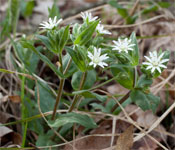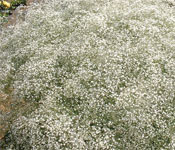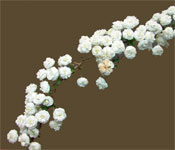Family – Pink Caryophyllaceae
Life Cycle – Simple perennial
Habitat – forage crops, hay fields, rangeland, roadsides, waste areas
Key Features
- Cotyledons and true leaves of seedling resemble each other
- Greyish-green “bloom” on stems and leaves due to glandular hair
- Delicate white “puffs” along prairie roadsides
Seedling
Cotyledons are linear. The true leaves are also linear, with entire margins and rounded tips. The leaves emerge in pairs and appear greyish-green. Seedlings are not often noticed.
Juvenile
Baby’s-breath has a deep, penetrating root system. The plant is erect with freely-branching stems that are smooth and swollen at the nodes. Stems and leaves are covered with glandular hair to give a greyish-green, waxy “bloom”. The leaves are opposite, entire-margined and linear to lanceolate with a single central vein.
Mature
Baby’s-breath plants resemble large, white powder puffs along prairie roadsides. The many small, white-petalled flowers in an open-branched inflorescence give this delicate “puffy” appearance. Each flower develops into a multi-seeded capsule containing tiny black, snail-like seeds with minute bumps and ridges. The mature, brittle stem breaks at the base and tumbles with the wind to distribute seed.
 |
 |
 |
